Previous Page | Right click this page to print.
Grouping, Feeding Management, and Rations
On an ideal dairy, we would have at least four to five heifer groups. Group one would be just after weaning. These animals would continue to receive a starter-grower that would be very important for the majority of their diet. And also high quality alfalfa hay. Groups two and three would still receive some concentrate but it would less important as these animals receive the majority of their nutrient requirements from forages, such as corn or grass silage, grass or legume hay. The concentrate would be supplemented to complement the forages being offered. Those animals in group three would be the pre-breeding group. Group four would be breeding age animals. They need very little grain, maybe only when forage quality is very poor. And group five would be bred heifers. They would receive the poorest quality forages on the farm and grains would only be supplemented when body condition dictated the need. As with any group of animals, the more groups means more finely-tuned rations. But more rations means the need to formulate and deliver more feedstuffs and therefore more labor.
Except for animals that are just newly weaned, forages are the staple in feeding dairy heifers and quality should be allocated to where it would be used best. Youngest heifers receive the highest quality forage, older heifers receive the poorest quality forage because they have the lowest nutritional priority of any heifer. Rations are always formulated to supplement forages. Forages are the foundation for dairy heifer rations.
There are advantages of complete diets for dairy heifers. A TMR or TMR
stands for a total mixed ration. TMRs minimize feed competition. For example,
animals do not compete like they would if grains were offered separately
from forages. Also, by-product feeds that would otherwise be unpalatable,
if offered separately, can be incorporated into TMRs. In general, feed
waste is less with TMRs. However, there are disadvantages. You need a
mix wagon. And even if a wagon is available for use, the group size may
be too small. For example, it would be unrealistic to mix a TMR for five
heifers. Based on adding small ingredients to the mix, for example, ten
pounds of something when the mix wagon rounds to the nearest ten pounds.
It is difficult to get adequate amounts of ingredients in the wagon and
also get a good mix.
Growth charts should be used routinely to monitor the nutrition program. You would need facilities to do this. The main facilities needed would be scales and facilities to get the animals to and from the scales. If you look at variation in growth rates, we have found that most of the variation is actually attributable to the environment rather than the feeding program. You must adjust the feeding program to match the animal’s growth or the environment they are exposed to. If animals are growing too rapidly, the ration must be adjusted to slow growth. If animals are growing too slowly that ration should be adjusted, energy and protein content should be increased, to increase growth. This is an example of a growth chart that is available from Penn State.
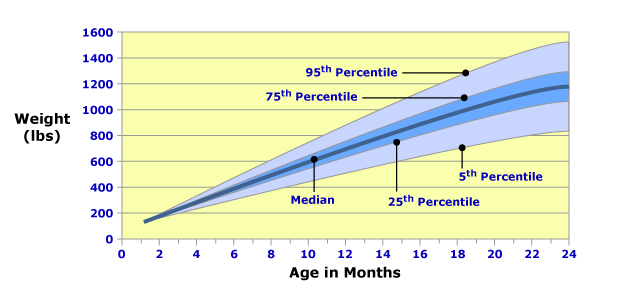
After animals are weighed, their weight, based upon age, is plotted on the graph and one can evaluate whether animals are growing too rapidly or too slowly. Now this chart was developed a number of years ago and it is probably out-dated for today’s modern Holstein heifers. The mean today would be about the 75th percentile. Growth charts are important. You can use growth charts to identify problem areas or problem age groups on your farm. Many times a group of heifers may be underweight for a particular age because of the facilities and growth charts can be used to identify these problem areas.
Next, we will look at some example rations from several commercial dairy heifer growers in the U.S. This is a converted beef feedlot in south Texas.
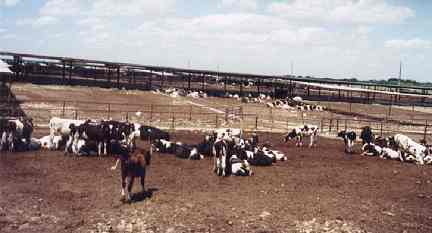
It has a one-time capacity of 9,800 dairy heifers. This is the diet for their 500-pound heifer group; their goal was 1.8 pounds of gain per day.
| Components of the Diet | |
|---|---|
Feed |
lb (as-fed) |
Cotton gin trash |
1.6 |
Rolled corn |
2.8 |
Distillers |
1.0 |
Cotton sweepings
|
0.8 |
Alfalfa hay |
2.2 |
Wheat midds |
3.6 |
Cottonseed meal
|
0.8 |
Sorghum silage
|
2.8 |
Milk |
4.0 |
The feed ingredients and the amount as fed are listed. Ingredients included in this diet were cotton gin trash, rolled corn, distiller’s, cotton sweepings or screenings, alfalfa hay, wheat midds, cottonseed meal, sorghum silage and milk. Some odd items in this TMR, primarily based upon location, is cotton gin trash, cotton sweepings and milk. Cotton gin trash is also known as cotton burrs. Cotton sweepings is the materials that they sweep off the gin floors after processing. Milk in this diet is quite interesting, especially since it is an older heifer diet. This grower also had a wet calf ranch and excess milk that was not used at the calf ranch was shipped to the heifer lot and added to the ration. The point is that this feedlot used a variety of ingredients to achieve a reasonable rate of growth, fairly cheaply.
13.8 lb. DMI |
17.0% CP |
1.67 Mcal/kg
NEM |
1.06 Mcal/kg
NEG |
36% NDF |
$0.63/day |
The target intake for these animals was 13.8 pounds per day. The diet contained 17 percent crude protein. The energy concentration for maintenance is 1.67 megacals per kilogram for NEG or net energy for gain it was about 1 megacal per kilogram. Thirty six (36) percent fiber or 36 percent neutral detergent fiber. And the cost was $.63 per head per day.
This is a picture of the cottonseed screenings.
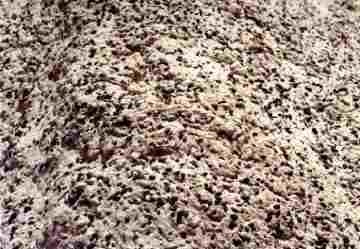
The black dots are cottonseed and the white material is lint.
This is two pictures of cottonseed burrs.
The upper left shows the burrs on growing cotton in the field.
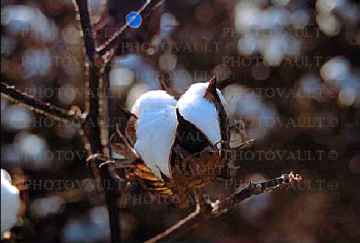
The lower right is a picture of what the burrs look like before incorporating into the ration at the farm.
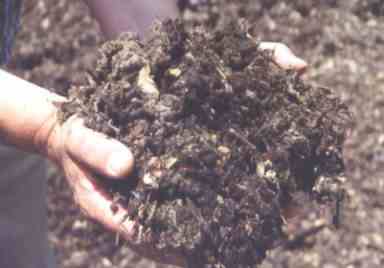
This is another converted beef feedlot that was converted to a dairy heifer lot in Colorado.
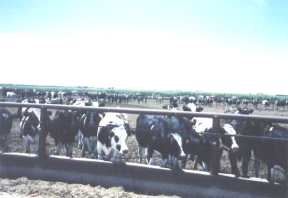
This was a 500-pound heifer diet with a target rate of gain of 1.5 pounds per day. Ingredients in the diet were wheat straw, wet brewer’s, carrots, beet pulp, corn screenings and alfalfa silage.
| Components of the Diet | |
|---|---|
Feed
|
lb (as-fed) |
Wheat straw |
3.2 |
Wet brewers |
6.4 |
Carrots |
4.0 |
Beet pulp |
4.0 |
Corn screenings
|
2.4 |
Alfalfa silage
|
8.0 |
Again, a diversity of ingredients that were offered to the heifers that met their target rate of growth.
| 13.2 lb. DMI |
| 11.2% CP |
| 1.40 Mcal/kg NEM |
| 0.82 Mcal/kg NEG |
| 46% NDF |
| $0.44/day |
The intake was 13.2 pounds per day. Protein 11.2. Net energy from maintenance 1.4 megacals per kilogram, net energy for gain .82 megacals per kilogram. Forty six (46) percent fiber. And this diet was very cheap, cost was $.44 per head per day. Actually, on the day that I visited this farm any ingredients that were in the ration that were not listed on this previous table were potatoes and onions, which are quite difficult to pick out in this TMR, but one thing that you can clearly see were the carrots.
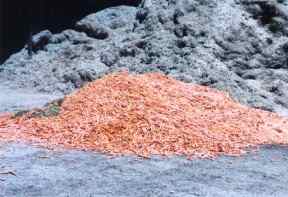
And each day they received a fresh load of carrots, were delivered to
the farm.
Previous Page | Right click this page to print.